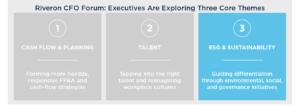CFOs Share Top Concerns – Part 3: ESG Strategies
Focusing on growth amid economic uncertainty? CFOs share key trends to move your organization forward.
A select group of chief financial officers (CFOs) from public and private companies recently convened with Riveron experts in a series of CFO forums to share leading concerns and insights as organizations seek to safeguard strength amid uncertainty. The forum revealed three key focal points for today’s CFOs, with environmental, social, and governance (ESG) factors emerging as a strategic avenue for driving a competitive edge:

Mission-linked ESG strategies offer a critical competitive advantage
As CFOs anticipate the Securities and Exchange Commission (SEC) to release a final rule on climate risk, they are also looking at the significance of ESG beyond financial reporting compliance. ESG is becoming a more prominent driver in organizational strategies and enterprise risk management, particularly as companies ease their recent efforts to ensure business health and continuity. The financial impacts of high energy costs or poor resource management may lead organizations to pursue renewable options for electricity and optimized operations. By doing so, companies will combine their economic and sustainability goals to improve both environmental impacts and the bottom line. For example, one CFO uncovered how switching a company’s fleet from traditional fuels to biodiesel provided both environmental benefits and an avenue for cost savings.
In general, leading organizations of all sizes are already embracing the core tenets of ESG to increase market value and differentiate themselves from competitors. Companies are also preparing for forthcoming regulatory requirements by implementing voluntary frameworks, such as the Task Force on Climate-related Financial Disclosures (TCFD), ahead of the SEC’s disclosure requirements, since the TCFD is a foundational basis for the proposed SEC climate rule.
While regulators and auditors will continue to refine the guardrails and guideposts that govern ESG disclosures, organizations are proceeding to build and stand up their own ESG reporting functions to satisfy the demands of partners, investors, employees, clients, and end-consumers. Specifically, when serving clients committed to ESG transformations, the vendors or suppliers for mission-driven organizations may have to meet new and evolving standards to maintain customer relationships. Here, some ESG data points and reporting requirements, such as completion of the CDP climate change questionnaire, are appearing on requests for proposals (RFPs) that the vendor organizations have recently received or anticipate receiving in the near future.
Setting ESG goals and reporting on a variety of environmental and social metrics links an organization’s reputation to progress on these goals. For some private companies or private-equity-backed companies developing an exit strategy, CFOs must consider potential future owners’ perspectives on ESG programs and calibrate energy and investments accordingly. Public company readiness —whether a company is planning for an acquisition or an initial public offering— will be an essential consideration for business leaders as ESG strategies and reporting expectations take shape.
For organizations with a broad stakeholder interest, initiating a committed ESG journey may require peer benchmarking and materiality studies to understand which sustainability topics should be prioritized and to focus the scope of strategic ESG investments. Establishing baseline greenhouse gas emissions and benchmarking against industry peers can demonstrate an organization’s relative positioning in the field before making specific ESG commitments.
“In each of your employee bases, there are people who are wildly passionate about this subject, and I’ve seen really cool programs accelerate with mid-level managers who are really passionate about ESG and get added to that steering committee and push things through a lot faster – with a perspective that you might need.”
-CFO Forum Participant
It is important for leaders to bear in mind that ESG’s value extends beyond the environmental aspect. Establishing an intentional strategy around social and cultural goals can impact investor relationships, customers, the public at large, and perhaps most meaningfully employee morale and retention. Not to be overlooked, talent retention may be driven by investment in training and development, employee benefits, health and safety, and other ESG-aligned “social” initiatives that lower turnover rates and related costs. These ESG-linked components align with each CFO’s priority of retaining talent in a manner that reinforces business strength and company culture in today’s volatile economic landscape.
Read other CFO insights in this series, including Part 1: Cash Flow & Planning strategies, plus considerations around employee retention and shaping a successful workplace culture in Part 2: Talent.
[1] Riveron CFO Forum hosts included Matt Bender, Eric Markovich, and Beth Saunders.

